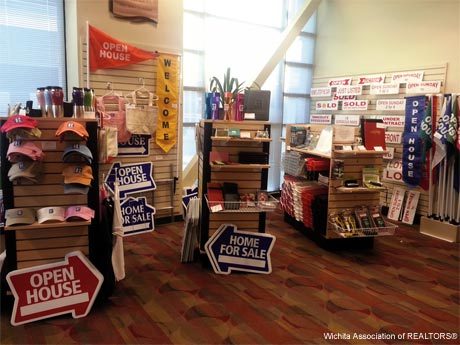 The store shelves and display cases at the Greater Nashville Association of REALTORS® building are coming down, its full-time retail clerk reassigned to member services. It’s a sign of the times, says Membership and Marketing Director Julie Davis. “With the change in the economy, and our change from classroom to online classes, we no longer need a full store, so we’re downsizing to just the most popular items, such as signs, pins, and logo coffee mugs.”
The store shelves and display cases at the Greater Nashville Association of REALTORS® building are coming down, its full-time retail clerk reassigned to member services. It’s a sign of the times, says Membership and Marketing Director Julie Davis. “With the change in the economy, and our change from classroom to online classes, we no longer need a full store, so we’re downsizing to just the most popular items, such as signs, pins, and logo coffee mugs.”
In its place, Nashville is building a member lounge where REALTORS® can access free Wi-Fi and coffee between appointments.
“We have seen many of our association customers closing their stores and consolidating,” says Renee Rocha, general manager of Real Estate Marketing Supplies.
Although cost-cutting has led many associations to shrink, eliminate, or move their stores online, some are still thriving.
Go Big
“As other REALTOR® association stores have closed in recent years, we have bought their merchandise and sold it to our members at significant discounts,” says Carl Carlson, the director of retail operations at the Sacramento Association of REALTORS®, Calif. Its 1,600-square-foot retail center, launched in 1995, is a “full shopping experience,” says Carlson, and offers everything from open house merchandise to LED lightbulbs, and even snacks. It ships to more than 40 states, and 27 percent of total sales come from its online store at www.realtysupplycenter.com.
The Massachusetts Association of REALTORS® used to have a physical store and a printed catalog but moved both to a hosted eCommerce Web site with an Amazon storefront. “I can’t say that it has been very successful, but at least we don’t have to buy and store inventory,” says Communications Director Eric Berman.
Move Online?
Closing a physical store and opening one online enables associations to maintain the valuable service, with less overhead and staff time. Jim Dunne, at REALTOR Team Store®, says many associations are migrating to its online revenue-share store model (a program available through an agreement with the REALTOR Benefits® Program). “Our store becomes their store,” he says. “They earn 5 percent on anything their members purchase.”
Despite the convenience of online shopping, physical association stores endure in part because the most popular items among members are typically large, bulky, and expensive to ship.
“We’ve held back from opening an online store because the majority of the items sold—like yard signs, brochure boxes, and open house banners—have packaging and shipping costs that are higher than the cost of the item itself,” says Perry Crume, senior vice president at the Kansas City Regional Association of REALTORS®. Crume maintains the physical store in the association’s lobby, where it nets about $30,000 per year (not including staff expenses). Profitability, however, is definitely not the norm. Many associations tell RAE that their stores fare just above break-even and aren’t designed to be profitcenters.
Store as Core Service
“Our store is set up as a core member service to provide discounted products. It’s not a losing proposition, but it’s not viewed as a traditional for-profit store,” says Erin Milburn, marketing and communications director at the Minneapolis Area Association of REALTORS®.
Likewise, the Emerald Coast Association of REALTORS® doesn’t run its store at a profit, selling items at only 15 percent above cost to cover vendors’ shipping costs, according to communications director Michaela Mitchell.
Unique Items Sell
Associations striving to build profits from their retail outlets have been successful with offering unique and discounted products.
“One reason our store has remained viable is that it works in close conjunction with our on-site real estate school and provides students with the necessary books and software for classes,” notes Carla Gaydos, the store manager at the Charlotte Regional REALTOR®
Association. The Charlotte store offers more than 400 items, with best sellers including yard signs, maps, and key boxes.
Other associations have found success attracting members with discounted movie tickets and hand-made closing gifts. The Columbus Board of REALTORS® went with the REALTOR® maxim location, location, location and housed its store just inside its main lobby.
Carlson says his store is successful because the focus is customer service and he follows product trends. “You have to have the right merchandise at the right price and the right display, and personalized riders are a must,” he says.
If you don’t already have a physical store, it would be very difficult to set one up today to be a profit center, cautions Dunne. “It involves tying up money, space, and personnel. In addition, you have to have a feel for the right items, what color, how many, plus the marketing and advertising expense.”
Ultimately, associations report, a retail outlet must be a member directive. If members aren’t supporting it enough that it breaks even, it’s time to choose between two paths: Promote its value to boost support, or phase it out.
REALTOR® Store Best Sellers
According to National Sign Display and REALTOR Team Store®, which both sell products to association stores, the best-selling items are lock boxes, pins, brochure boxes, and all types of garments and awards. “Currently, accessories for all types of electronic items (iPad, iPhones, BlackBerries) are very popular,” notes Jim Dunne at REALTOR Team Store®.












